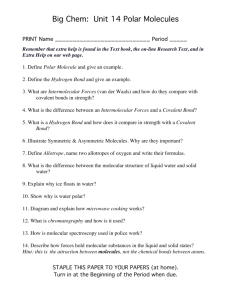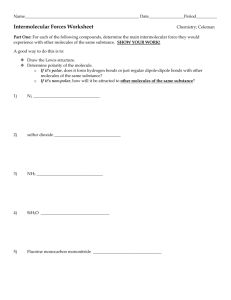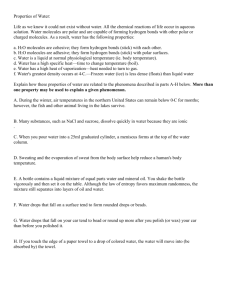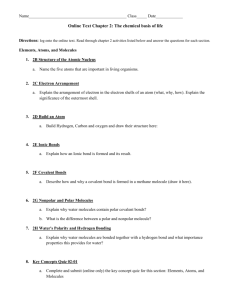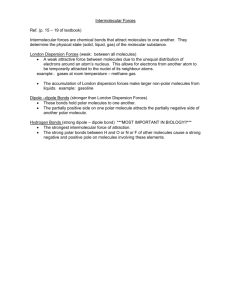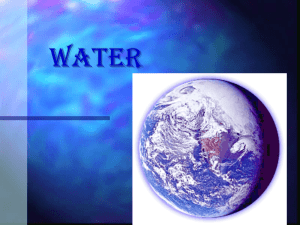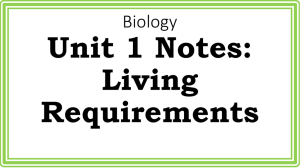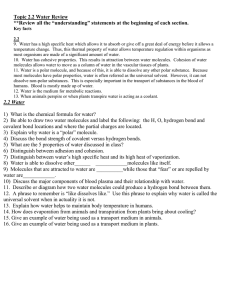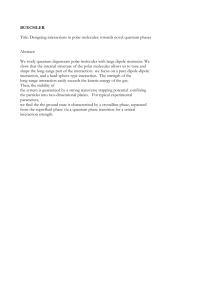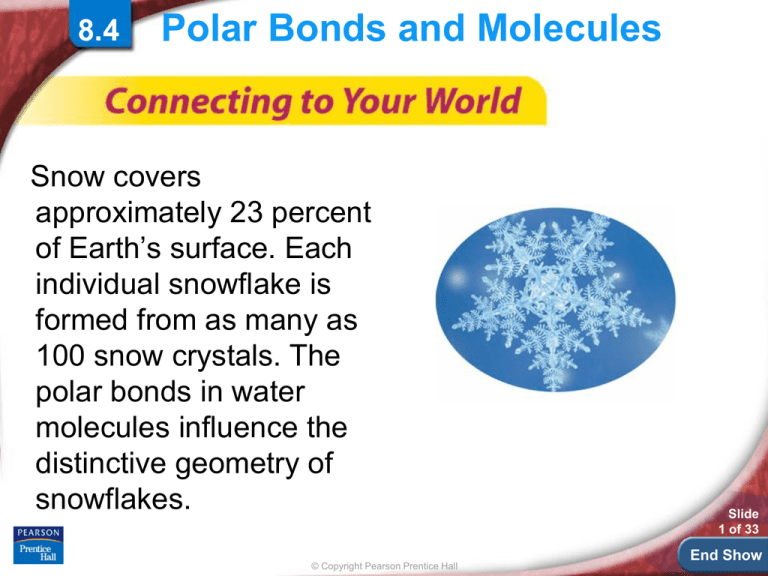
8.4
Polar Bonds and Molecules
Snow covers
approximately 23 percent
of Earth’s surface. Each
individual snowflake is
formed from as many as
100 snow crystals. The
polar bonds in water
molecules influence the
distinctive geometry of
snowflakes.
© Copyright Pearson Prentice Hall
Slide
1 of 33
End Show
8.4
Polar Bonds and
Molecules
>
Bond Polarity
Bond Polarity
How do electronegativity values
determine the charge distribution in a
polar bond?
Slide
2 of 33
© Copyright Pearson Prentice Hall
End Show
8.4
Polar Bonds and
Molecules
>
Bond Polarity
When the atoms in a bond pull equally (as
occurs when identical atoms are bonded), the
bonding electrons are shared equally, and the
bond is a nonpolar covalent bond.
Slide
3 of 33
© Copyright Pearson Prentice Hall
End Show
8.4
Polar Bonds and
Molecules
>
Bond Polarity
The bonding pairs of electrons in covalent bonds
are pulled by the nuclei.
Slide
4 of 33
© Copyright Pearson Prentice Hall
End Show
8.4
Polar Bonds and
Molecules
>
Bond Polarity
The chlorine atom attracts the electron cloud
more than the hydrogen atom does.
Slide
5 of 33
© Copyright Pearson Prentice Hall
End Show
8.4
Polar Bonds and
Molecules
>
Bond Polarity
A polar covalent bond, known also as a polar
bond, is a covalent bond between atoms in which
the electrons are shared unequally.
The more electronegative atom attracts
electrons more strongly and gains a
slightly negative charge. The less
electronegative atom has a slightly
positive charge.
Slide
6 of 33
© Copyright Pearson Prentice Hall
End Show
8.4
Polar Bonds and
Molecules
>
Bond Polarity
Notes from WB: as the difference in electronegativity between the atoms
in the bond increases the ionic character of the bond increases and the
covalent character decreases.
Ionic bonds are generally formed between metals and nonmetals.
WB gives the range for ionic bonds to be a difference of greater than or
equal to 1.7 but you will need to consider the type of elements as well
as the electronegativity values. HF, for example , has a polar covalent
bond (not an ionic bond).
© Copyright Pearson Prentice Hall
Slide
7 of 33
End Show
8.4
Polar Bonds and
Molecules
>
Polar Molecules
Polar Molecules
What happens to polar molecules
between a pair of oppositely charged
metal plates?
Slide
8 of 33
© Copyright Pearson Prentice Hall
End Show
8.4
Polar Bonds and
Molecules
>
Polar Molecules
In a polar molecule, one end of the molecule is
slightly negative and the other end is slightly
positive.
A molecule that has two poles is called a dipolar
molecule, or dipole.
Slide
9 of 33
© Copyright Pearson Prentice Hall
End Show
8.4
Polar Bonds and
Molecules
>
Polar Molecules
When polar molecules are placed
between oppositely charged plates, they
tend to become oriented with respect to
the positive and negative plates.
Slide
10 of 33
© Copyright Pearson Prentice Hall
End Show
8.4
Polar Bonds and
Molecules
>
Polar Molecules
A hydrogen chloride molecule is a dipole.
Slide
11 of 33
© Copyright Pearson Prentice Hall
End Show
Polar Bonds and
Molecules
>
Polar Molecules
Animation 10 Learn to distinguish between
polar and nonpolar molecules.
Slide
12 of 33
© Copyright Pearson Prentice Hall
End Show
8.4
Polar Bonds and
Molecules
>
Attractions Between Molecules
Attractions Between Molecules
How do intermolecular attractions
compare with ionic and covalent bonds?
Slide
13 of 33
© Copyright Pearson Prentice Hall
End Show
8.4
Polar Bonds and
Molecules
>
Attractions Between Molecules
Intermolecular attractions are weaker
than either ionic or covalent bonds.
These attractions are responsible for
determining whether a molecular compound
is a gas, a liquid, or a solid at a given
temperature.
Slide
14 of 33
© Copyright Pearson Prentice Hall
End Show
8.4
Polar Bonds and
Molecules
>
Attractions Between Molecules
Van der Waals Forces
The two weakest attractions between molecules
are collectively called van der Waals forces,
named after the Dutch chemist Johannes van
der Waals (1837–1923).
Slide
15 of 33
© Copyright Pearson Prentice Hall
End Show
8.4
Polar Bonds and
Molecules
>
Attractions Between Molecules
Dipole interactions
occur when polar
molecules are
attracted to one
another.
Slide
16 of 33
© Copyright Pearson Prentice Hall
End Show
8.4
Polar Bonds and
Molecules
>
Attractions Between Molecules
Dispersion forces, the weakest of all molecular
interactions, are caused by the motion of
electrons.
The strength of dispersion forces generally
increases as the number of electrons in a
molecule increases.
Slide
17 of 33
© Copyright Pearson Prentice Hall
End Show
Polar Bonds and
Molecules
>
What are van der waals forces?
http://antoine.frostburg.edu/chem/senese/101
/liquids/faq/h-bonding-vs-london-forces.shtml
Hydrogen bonding video:
http://www.youtube.com/watch?v=LGwyB
euVjhU
Slide
18 of 33
© Copyright Pearson Prentice Hall
End Show
8.4
Polar Bonds and
Molecules
>
Attractions Between Molecules
Hydrogen Bonds
Hydrogen bonds are attractive forces in which
a hydrogen covalently bonded to a very
electronegative atom is also weakly bonded to
an unshared electron pair of another
electronegative atom.
Slide
19 of 33
© Copyright Pearson Prentice Hall
End Show
8.4
Polar Bonds and
Molecules
>
Attractions Between Molecules
Hydrogen Bonding in Water
Slide
20 of 33
© Copyright Pearson Prentice Hall
End Show
8.4
Polar Bonds and
Molecules
>
Attractions Between Molecules
The relatively strong attractive forces between
water molecules cause the water to form small
drops on a waxy surface.
Slide
21 of 33
© Copyright Pearson Prentice Hall
End Show
8.4
Polar Bonds and
Molecules
>
Intermolecular Attractions and Molecular
Properties
Intermolecular Attractions and Molecular
Properties
Why do network solids have high
melting points?
Slide
22 of 33
© Copyright Pearson Prentice Hall
End Show
8.4
Polar Bonds and
Molecules
>
Intermolecular Attractions and Molecular
Properties
Network solids (or network crystals) are solids
in which all of the atoms are covalently bonded
to each other.
Network solids consist of molecules that do not
melt until the temperature reaches 1000°C or
higher, or they decompose without melting at all.
Slide
23 of 33
© Copyright Pearson Prentice Hall
End Show
8.4
Polar Bonds and
Molecules
>
Intermolecular Properties and Molecular
Properties
Melting a network solid would require
breaking covalent bonds throughout the
solid.
Slide
24 of 33
© Copyright Pearson Prentice Hall
End Show
8.4
Polar Bonds and
Molecules
>
Intermolecular Attractions and Molecular
Properties
Diamond is an example of a network solid.
Diamond does not melt. It vaporizes to a gas at
3500°C or above.
Slide
25 of 33
© Copyright Pearson Prentice Hall
End Show
8.4
Polar Bonds and
Molecules
>
Intermolecular Attractions and Molecular
Properties
Silicon Carbide is a network solid. It has a
melting point of about 2700°C.
Slide
26 of 33
© Copyright Pearson Prentice Hall
End Show
Polar Bonds and
Molecules
>
Intermolecular Attractions and Molecular
Properties
Simulation 8 Relate melting and boiling
points to the strength of intermolecular forces.
Slide
27 of 33
© Copyright Pearson Prentice Hall
End Show
8.4
Polar Bonds and
Molecules
>
Intermolecular Attractions and Molecular
Properties
Slide
28 of 33
© Copyright Pearson Prentice Hall
End Show
8.4 Section Quiz.
Assess students’ understanding
of the concepts in Section 8.4.
Continue to:
-or-
Launch:
Section Quiz
Slide
29 of 33
© Copyright Pearson Prentice Hall
End Show
8.4 Section Quiz.
1. In a molecule, the atom with the largest
electronegativity value
a. repels electrons more strongly and aquires a
slightly negative charge.
b. repels electrons more strongly and aquires a
slightly positive charge.
c. attracts electrons more strongly and aquires a
slightly positive charge.
d. attracts electrons more strongly and aquires a
slightly negative charge.
Slide
30 of 33
© Copyright Pearson Prentice Hall
End Show
8.4 Section Quiz.
2. When polar molecules are placed between
oppositely charged plates, the negative
a. molecules stick to the positive plates.
b. molecules stick to the negative plates.
c. ends of the molecules turn toward the
positive plates.
d. ends of the molecules turn toward the
negative plates.
Slide
31 of 33
© Copyright Pearson Prentice Hall
End Show
8.4 Section Quiz.
3. Which of the following bond types is the
weakest?
a. ionic bond
b. Van der Waals force
c. covalent bond
d. hydrogen bond
Slide
32 of 33
© Copyright Pearson Prentice Hall
End Show

